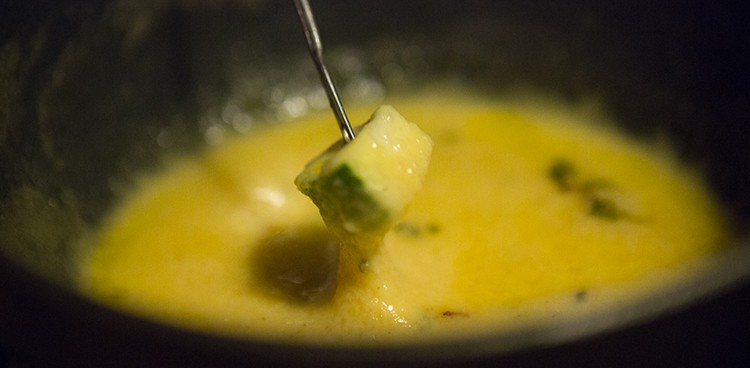
Corruption. Coercion. Jail time. Nope, not the plot twists of a latest crime novel but, in fact, part of the shadowy stories behind the history of fondue. NPR’s Robert Smith recently ran a story that sheds some light on the shady happenings behind why we eat, and love, gobs of the melted-cheese-and-bread dish. The story reads like a good old fashioned mafia tale except instead of the mafia, the Schweizer Käseunion, or the Swiss Cheese Union, called the shots.
That’s right: The Swiss Cheese Union was a band of all-powerful cheesemakers that arose in Switzerland right after World War I, a time when Europe was almost completely destroyed, save for most of Switzerland, its cows, and lots and lots of cheese. Demand for cheese suddenly plummeted, causing supply to boom. Because of the ever-increasing supply of available cheese in Switzerland at the time, some cheesemakers decided to form a cartel, an agreement among competitors to control prices and not to compete. Yup, price fixing, supply reduction, and demand increases. (Bet you haven’t seen those words since that undergrad Econ class, huh?) Enter, the Schweizer Käseunion.
With its 1914 inception, this cartel set the country’s price for milk, limited the production of milk and cheese, and restricted the kinds of cheese that other, smaller cheesemakers could produce. The Swiss Cheese Union mandated that cheese production be limited to only three varieties of cheese: Emmentaler, Gruyère, and Sbrinz. Cheesemakers selling any other cheese had to either cease production or find other, more “creative” (and illegal) ways to sell their cheeses to consumers. In the 1950s and ’60s, the Swiss Cheese Union wanted to not only boost supply of the country’s cheese inventory, but also increase demand for it.

Photo credit: Dinnerisserved1972.com
But how does a country rally its people to eat or drink more of a certain food, particularly a food that is high in fat and calories? Easy: Show beautiful people “partying over” pots of that food—in this case, cheese—in fancy, eye-catching advertisements. And that’s exactly what the Swiss government did throughout the 1970s. As Smith notes, marketing gobs of melted cheese as a “healthy food from the Alps,” these ads of good-looking Swiss people promoted a new, patriotic dish, formerly thought of as simply a part of regional cuisine but now a stake in the history of Switzerland. Thanks to the aggressive marketing push, fondue’s popularly skyrocketed. Hey, when all the cool Swiss kids are dipping stale cubes of bread into pots of melted cheese, everyone’s going to want to start doing the same thing. And that’s when the boom of fondue started. Suddenly, fondue became an iconic part of Swiss culture.
But when you’re at the top, the only place to go is down. Throughout the ’70s, ’80s, and ’90s, the Swiss government was throwing so much money to cheese and fondue subsidies. By 1999, in a mess that included allegations that the Swiss Cheese Union was being guided by corruption, the cartel that started it all collapsed. Finally, after nearly a century of being subject to the cartel’s restrictive cheese production rules, Swiss cheese makers could once again make and sell any type of cheese they desired. But the love of fondue stuck like cheese to bread. According to NPR’s Robert Smith, the Swiss still urge both natives and tourists alike to enjoy each pot of melted cheese to the last, well, drop. As a waiter told Smith while in Switzerland, the “end of the fondue is the best part.” End. Beginning. We love fondue wherever we start dipping.
Listen to the whole story:
Audio Player


